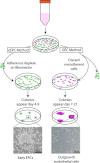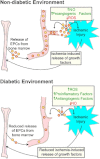Endothelial progenitor dysfunction in the pathogenesis of diabetic retinopathy: treatment concept to correct diabetes-associated deficits
- PMID: 21494317
- PMCID: PMC3008583
- DOI: 10.1007/s13167-010-0011-8
Endothelial progenitor dysfunction in the pathogenesis of diabetic retinopathy: treatment concept to correct diabetes-associated deficits
Abstract
Progressive obliteration of the retinal microvessels is a characteristic of diabetic retinopathy and the resultant retinal ischemia can lead to sight-threatening macular edema, macular ischemia and ultimately preretinal neovascularization. Bone marrow derived endothelial progenitor cells (EPCs) play a critical role in vascular maintenance and repair. There is still great debate about the most appropriate markers that define an EPC. EPCs can be isolated using cell sorting by surface phenotype selection or in vitro cell culture. For freshly isolated cells, EPC cell sorting is heavily dependent on the surface markers used; EPCs can also be isolated by in vitro propagation of heterogeneous mixtures of cells in culture using adhesion to specific substrates and cell growth characteristics. in vitro isolation enables consistent reproducibility and using this approach at least two distinct types of EPCs with different angiogenic properties have been identified from adult peripheral and umbilical cord blood; early EPCs (eEPCs) and late outgrowth endothelial progenitor cells (OECs). Emerging studies demonstrate the potential of these cells in revascularization of ischemic/injured retina in animal models of retinal disease. Since ischemic retinopathies are leading causes of blindness, they are a potential disease target for EPC-based therapy. In this chapter, we summarize the current knowledge about EPCs and discuss the possibility of cellular therapy for treatment of diabetic macular ischemia and the vasodegenerative phase of diabetic retinopathy. We also report current pharmacological options that can be utilized to correct diabetes associated defects in EPCs so as to enhance the therapeutic utility of these cells.
Figures






Similar articles
-
Promise of endothelial progenitor cell for treatment of diabetic retinopathy.Expert Rev Endocrinol Metab. 2010 Jan;5(1):29-37. doi: 10.1586/eem.09.75. Expert Rev Endocrinol Metab. 2010. PMID: 23678364 Free PMC article.
-
Outgrowth endothelial cells: characterization and their potential for reversing ischemic retinopathy.Invest Ophthalmol Vis Sci. 2010 Nov;51(11):5906-13. doi: 10.1167/iovs.09-4951. Epub 2010 Jun 16. Invest Ophthalmol Vis Sci. 2010. PMID: 20554606
-
Endothelial progenitor cells (EPCs) mobilized and activated by neurotrophic factors may contribute to pathologic neovascularization in diabetic retinopathy.Am J Pathol. 2010 Jan;176(1):504-15. doi: 10.2353/ajpath.2010.081152. Epub 2009 Nov 30. Am J Pathol. 2010. PMID: 19948824 Free PMC article.
-
Dysfunction and Therapeutic Potential of Endothelial Progenitor Cells in Diabetes Mellitus.J Clin Med Res. 2018 Oct;10(10):752-757. doi: 10.14740/jocmr3581w. Epub 2018 Sep 10. J Clin Med Res. 2018. PMID: 30214646 Free PMC article. Review.
-
Advances in cell therapies using stem cells/progenitors as a novel approach for neurovascular repair of the diabetic retina.Stem Cell Res Ther. 2022 Jul 30;13(1):388. doi: 10.1186/s13287-022-03073-x. Stem Cell Res Ther. 2022. PMID: 35907890 Free PMC article. Review.
Cited by
-
New insight of metabolomics in ocular diseases in the context of 3P medicine.EPMA J. 2023 Feb 17;14(1):53-71. doi: 10.1007/s13167-023-00313-9. eCollection 2023 Mar. EPMA J. 2023. PMID: 36866159 Free PMC article. Review.
-
Evidence of altered brain network centrality in patients with diabetic nephropathy and retinopathy: an fMRI study using a voxel-wise degree centrality approach.Ther Adv Endocrinol Metab. 2019 Jul 27;10:2042018819865723. doi: 10.1177/2042018819865723. eCollection 2019. Ther Adv Endocrinol Metab. 2019. PMID: 31384421 Free PMC article.
-
Endothelial Progenitor Cells and Cardiovascular Correlates.Cureus. 2018 Sep 21;10(9):e3342. doi: 10.7759/cureus.3342. Cureus. 2018. PMID: 30473975 Free PMC article. Review.
-
Loss of Angiotensin-Converting Enzyme 2 Exacerbates Diabetic Retinopathy by Promoting Bone Marrow Dysfunction.Stem Cells. 2018 Sep;36(9):1430-1440. doi: 10.1002/stem.2848. Epub 2018 Jul 15. Stem Cells. 2018. PMID: 29761600 Free PMC article.
-
Platelet-Derived Growth Factor-BB Priming Enhances Vasculogenic Capacity of Bone Marrow-Derived Endothelial Precursor Like Cells.Tissue Eng Regen Med. 2023 Aug;20(5):695-704. doi: 10.1007/s13770-023-00546-9. Epub 2023 Jun 2. Tissue Eng Regen Med. 2023. PMID: 37266845 Free PMC article.
References
-
- ETDRS Early photocoagulation for diabetic retinopathy. ETDRS report number 9. Early Treatment Diabetic Retinopathy Study Research Group. Ophthalmology. 1991;98:766–85. - PubMed
-
- ETDRS Focal photocoagulation treatment of diabetic macular edema. ETDRS Report Number 19. Arch Ophthalmol. 1995;113:1144–55. - PubMed
-
- Domen J, Wagers A, Weissman IL. Bone Marrow (hematiopoietic) Stem Cells [Online]. 2006.
Grants and funding
LinkOut - more resources
Full Text Sources

